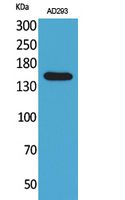NTE Polyclonal Antibody
- Catalog No.:YT5363
- Applications:WB;IHC;IF;ELISA
- Reactivity:Human;Mouse;Rat
- Target:
- NTE
- Fields:
- >>Glycerophospholipid metabolism
- Gene Name:
- PNPLA6
- Protein Name:
- Neuropathy target esterase
- Human Gene Id:
- 10908
- Human Swiss Prot No:
- Q8IY17
- Mouse Gene Id:
- 50767
- Mouse Swiss Prot No:
- Q3TRM4
- Immunogen:
- The antiserum was produced against synthesized peptide derived from the Internal region of human PNPLA6. AA range:1031-1080
- Specificity:
- NTE Polyclonal Antibody detects endogenous levels of NTE protein.
- Formulation:
- Liquid in PBS containing 50% glycerol, 0.5% BSA and 0.02% sodium azide.
- Source:
- Polyclonal, Rabbit,IgG
- Dilution:
- WB 1:500 - 1:2000. IHC: 1:100-1:300. ELISA: 1:20000.. IF 1:50-200
- Purification:
- The antibody was affinity-purified from rabbit antiserum by affinity-chromatography using epitope-specific immunogen.
- Concentration:
- 1 mg/ml
- Storage Stability:
- -15°C to -25°C/1 year(Do not lower than -25°C)
- Other Name:
- PNPLA6;NTE;Neuropathy target esterase;Patatin-like phospholipase domain-containing protein 6
- Observed Band(KD):
- 150kD
- Background:
- This gene encodes a phospholipase that deacetylates intracellular phosphatidylcholine to produce glycerophosphocholine. It is thought to function in neurite outgrowth and process elongation during neuronal differentiation. The protein is anchored to the cytoplasmic face of the endoplasmic reticulum in both neurons and non-neuronal cells. Mutations in this gene result in autosomal recessive spastic paraplegia, and the protein is the target for neurodegeneration induced by organophosphorus compounds and chemical warfare agents. Multiple transcript variants encoding different isoforms have been found for this gene. [provided by RefSeq, Oct 2009],
- Function:
- catalytic activity:2-lysophosphatidylcholine + H(2)O = glycerophosphocholine + a carboxylate.,disease:Defects in PNPLA6 are the cause of spastic paraplegia autosomal recessive type 39 (SPG39) [MIM:612020]; also known as NTE-related motor neuron disorder (NTEMND). Spastic paraplegia is a neurodegenerative disorder characterized by a slow, gradual, progressive weakness and spasticity of the lower limbs. Rate of progression and the severity of symptoms are quite variable. Initial symptoms may include difficulty with balance, weakness and stiffness in the legs, muscle spasms, and dragging the toes when walking. In some forms of the disorder, bladder symptoms (such as incontinence) may appear, or the weakness and stiffness may spread to other parts of the body. SPG39 is associated with a motor axonopathy affecting upper and lower limbs and resulting in progressive wasting of distal upper and
- Subcellular Location:
- Endoplasmic reticulum membrane ; Single-pass type III membrane protein .
- Expression:
- Expressed in brain, placenta, kidney, neuron and skeletal muscle. Expressed in the developing eye, pituitary and brain.
- June 19-2018
- WESTERN IMMUNOBLOTTING PROTOCOL
- June 19-2018
- IMMUNOHISTOCHEMISTRY-PARAFFIN PROTOCOL
- June 19-2018
- IMMUNOFLUORESCENCE PROTOCOL
- September 08-2020
- FLOW-CYTOMEYRT-PROTOCOL
- May 20-2022
- Cell-Based ELISA│解您多样本WB检测之困扰
- July 13-2018
- CELL-BASED-ELISA-PROTOCOL-FOR-ACETYL-PROTEIN
- July 13-2018
- CELL-BASED-ELISA-PROTOCOL-FOR-PHOSPHO-PROTEIN
- July 13-2018
- Antibody-FAQs
- Products Images

- Western Blot analysis of AD293 cells using NTE Polyclonal Antibody. Secondary antibody(catalog#:RS0002) was diluted at 1:20000
.jpg)
- Immunohistochemical analysis of paraffin-embedded rat-testis, antibody was diluted at 1:100

- Immunohistochemical analysis of paraffin-embedded rat-testis, antibody was diluted at 1:100

- Western blot analysis of lysate from AD293 cells, using PNPLA6 Antibody.



